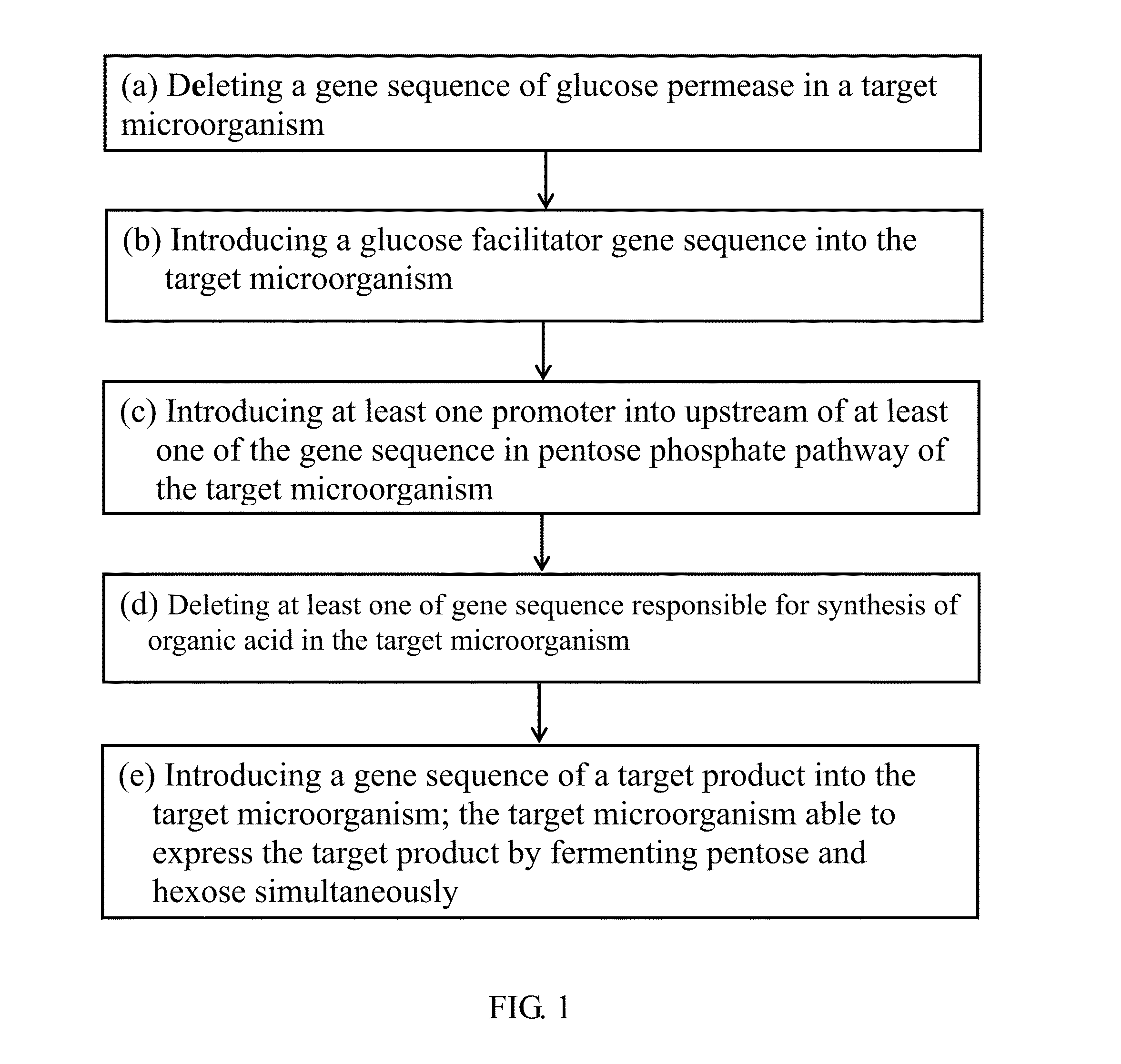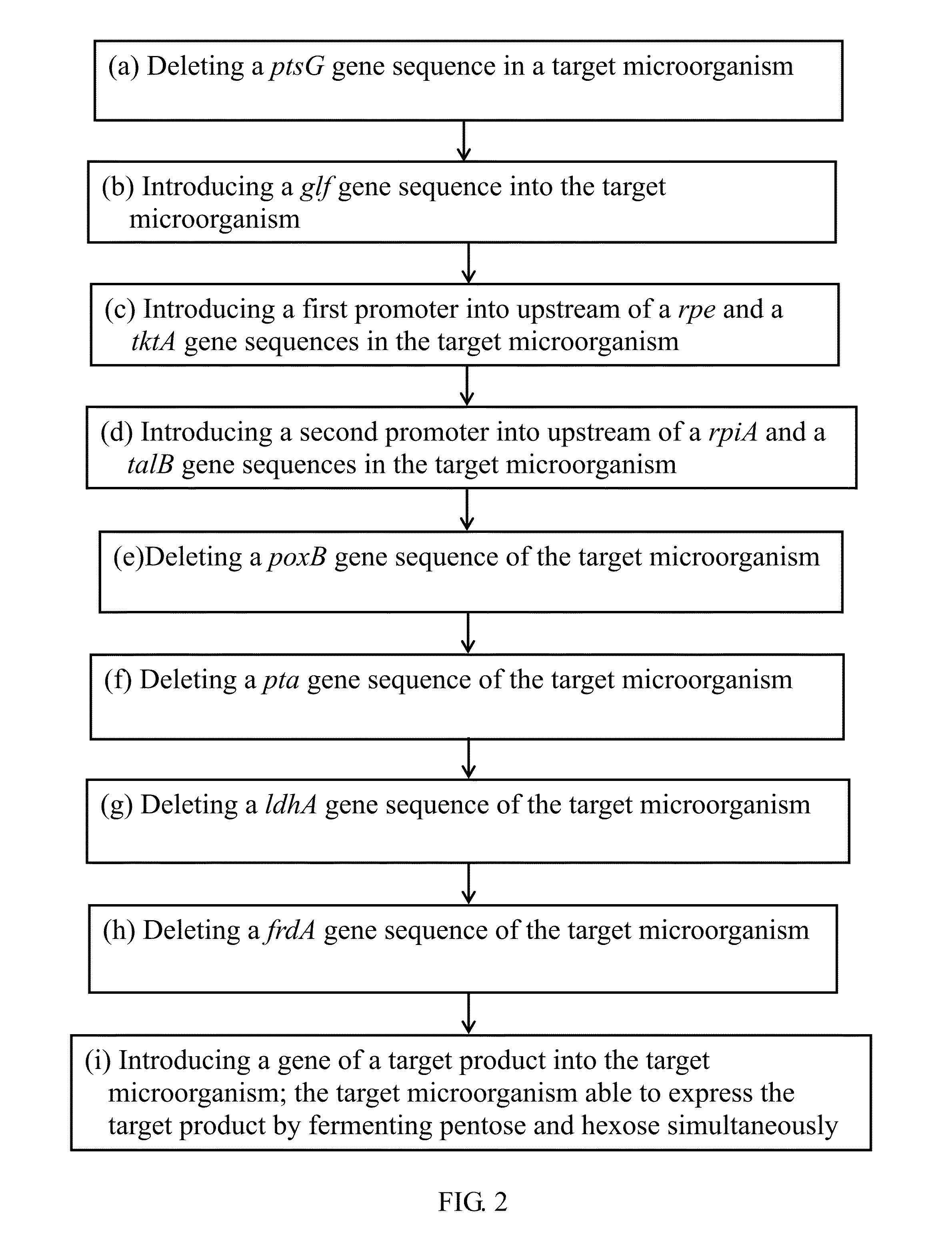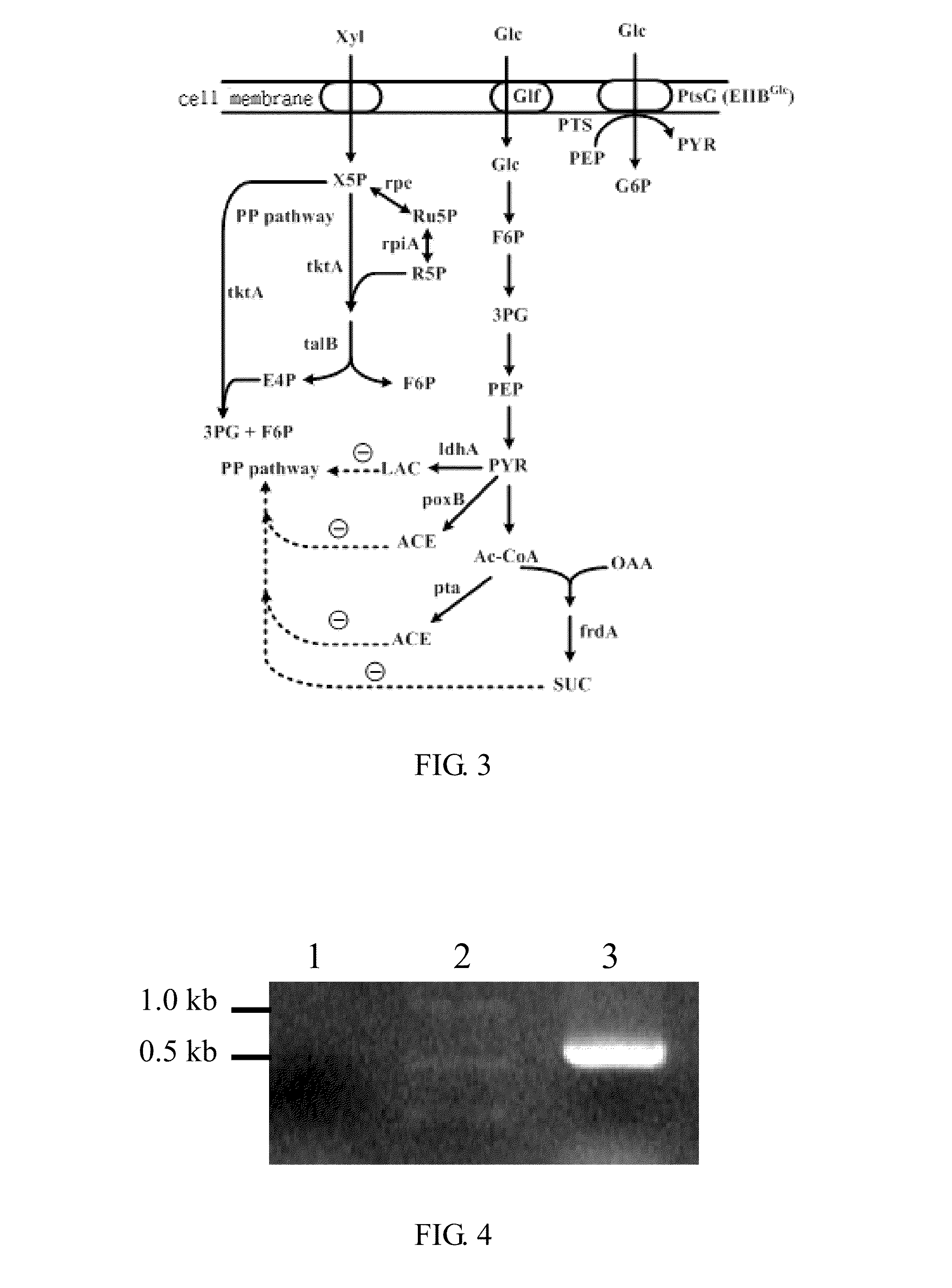Method for Simultaneous Fermentation of Pentose and Hexose
a simultaneous fermentation and pentose technology, applied in the direction of bacteria peptides, transferases, peptide sources, etc., can solve the problems of affecting the development of biorefinery industry, xylose fermentation is not complete, other metabolism is not complete, etc., to achieve easy fermentation operation, simple media formula, and rapid growth
- Summary
- Abstract
- Description
- Claims
- Application Information
AI Technical Summary
Benefits of technology
Problems solved by technology
Method used
Image
Examples
embodiment 1
[0042]Deletion of a ptsG Gene Sequence
[0043]In step (a) of FIG. 2, to reduce a catabolite repression effect, the ptsG gene encoding glucose permease in the phosphotransferase system is deleted from the chromosome of E. coli strain BL21. The purpose of this approach is to make the bacterial strain able to uptake both of xylose and glucose; consequently, to metabolize them. Primer 1 and 2 are synthesized based on the adjacent sequence of the ptsG gene sequence according to the EcoCye database.
Forward primer l(SEQ ID NO: 1)(5′-TGGGTGAAACCGGGCTGG)Reverse primer 2(SEQ ID NO: 2)(5′-AGCCGTCTGACCACCACG)Forward primer 3(SEQ ID NO: 3)(5′-GATTGAACAAGATGGATTGC)Reverse primer 4(SEQ ID NO: 4)(5′-GAAGAACTCGTCAAGAAGGC)
[0044]The PCR reaction is carried out using the purified chromosome of E. coli strain CGSC 9031(E. coli Genetic Stock Center, USA) as the template and with primer 1 and primer 2. A DNA cassette (2.8 kb) is amplified, and it contained the FRT sites-surrounded anti-kanamycin gene (FRT-k...
embodiment 2
[0069]Production of Ethanol in the Constructed Strain by Fermentation of Glucose and Xylose
[0070]Construction of Plasmid pND-Pet
[0071]The pdc gene encoding pyruvate decarboxylase and the adhII gene encoding alcohol dehydrogenas from Z. mobilis have been studied previously (Ingram Lo et al., 1987, Appl. Environ. Microbiol. 53:2420-2425). The two genes mediate a two-step reaction by conversion of pyruvate to ethanol. In the step (i) of FIG. 2, to enhance ethanol production in E. coli, the pdc and adhII genes are introduced into the genetically constructed E. coli strains as detailed in the following.
Forward primer 35(SEQ ID NO: 35)(5′-TATACATATGAGTTATACTGTCGGTAC)Reverse primer 36(SEQ ID NO: 36)(5′-CCATGGATCCTTATCCTCCTCCGAGGAGCTTG)Forward primer 37(SEQ ID NO: 37)(5′-ATGTGGATCCAGGATATAGCTATGGCTTCTTCAACTTTTTATATTC)Reverse primer 38(SEQ ID NO: 38)(5′-AGGACTCGAGTTAGAAAGCGCTCAGGAAGAG)
[0072]Primers 35 and 36 are synthesized according to the pdc gene sequence in NCBI database; the forward pri...
embodiment 3
[0082]Lactate Production by Simultaneous Fermentation of Xylose and Glucose
[0083]Another example is shown in step (i) of FIG. 2. A single colony of BL-A4 / pTrc-H / D-Ldh is picked up and cultured in the LB broth (5 mL) with ampicillin at 37° C. and 200 rpm overnight. The overnight culture is seeded into 25 mL fresh LB broth with ampicillin plus 1% glucose and 1% xylose. The initial optical density (550 nm) of the culture is maintained at 0.1. The bacterial culture is then incubated at 37° C. and 200 rpm. When the optical density (550 nm) reaching 0.3, the 300 μM Isopropyl β-D-1-thiogalactopyranoside (IPTG) is added to the culture broth to induce expression of the ldhA gene sequence in strain BL-A4 / pTrc-H / D-Ldh. Meanwhile, the concentration of glucose, xylose, and lactate is measured along the time course. In FIG. 24, glucose (•) and xylose (∇) are consumed simultaneously and rapidly by strain BL-A4 / pTrc-H / D-Ldh. Moreover, 160 mM of lactate () is produced after 48-hour fermentation and ...
PUM
| Property | Measurement | Unit |
|---|---|---|
| wave length | aaaaa | aaaaa |
| culture temperature | aaaaa | aaaaa |
| temperature | aaaaa | aaaaa |
Abstract
Description
Claims
Application Information
 Login to View More
Login to View More - R&D
- Intellectual Property
- Life Sciences
- Materials
- Tech Scout
- Unparalleled Data Quality
- Higher Quality Content
- 60% Fewer Hallucinations
Browse by: Latest US Patents, China's latest patents, Technical Efficacy Thesaurus, Application Domain, Technology Topic, Popular Technical Reports.
© 2025 PatSnap. All rights reserved.Legal|Privacy policy|Modern Slavery Act Transparency Statement|Sitemap|About US| Contact US: help@patsnap.com



